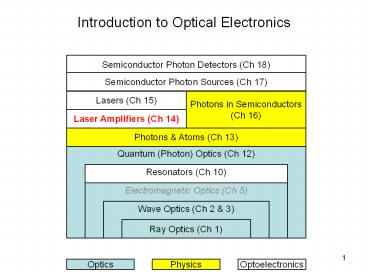Introduction to Optical Electronics PowerPoint PPT Presentation
1 / 25
Title: Introduction to Optical Electronics
1
Introduction to Optical Electronics
2
Laser Amplilfiers
3
Gain Phase CoefficientsLorentzian Lineshape
4
Exercise 13.1-1Attenuation and Gain in a Ruby
Laser Amplifier
- Consider a ruby crystal with two energy levels
separated by an energy difference corresponding
to a free-space wavelength ?0 694.3 nm, with a
Lorentzian lineshape of width ?? 60 GHz. The
spontaneous lifetime is tsp 3 ms and the
refractive index of ruby is n 1.76. If N1 N2
Na 1022 cm-3, determine the population
difference N N2 N1 and the attenuation
coefficient at the line center ?(?0) under
conditions of thermal equilibrium (so that the
Boltzmann distribution is obeyed) at T 300 K. - What value should the population difference N
assume to achieve a gain coefficient ?(?0) 0.5
cm-1 at the central frequency? - How long should the crystal be to provide an
overall gain of 4 at the central frequency when
?(?0) 0.5 cm-1 ?
5
Rate Equations
- Understanding Lifetimes
- ?1 and ?2 are overall lifetimes for atomic energy
levels 1 and 2. - Lifetime of level 2 has two contributions
- (where rates are inversely proportional to decay
times) - and
- Population densities N1 and N2 will vanish unless
another mechanism is employed to increase
occupation
6
Rate Equations Absence of Amplifier Radiation
- Pumping Rates R1 R2 defined
- Rate Equations
- Steady-State Conditions
7
Exercise 13.2-1Optical Pumping
- Assume that R1 0 and that R2 is realized by
exciting atoms from the ground state E 0 to
level 2 using photons of frequency E2 / h
absorbed with a transition probability W. Assume
that ?2 tsp, and ?1 ltlt tsp so that in steady
state N1 0 and N0 R2 tsp. If Na is the total
population of levels 0, 1, and 2, show that R2
(Na 2N0)W, so that the population difference is
N0 Na tsp W / (1 2 tsp W)
8
Rate Equations Presence of Amplifier Radiation
- Pumping Rates
- Four Case Studies
- (Homogeneous Broadened Transitions)
- I? 0, R2(t) R20 u(t), R1(t) 0
- ?1 0, R2(t) R20 u(t)
- ?1 0, R2(t) R20, I? Pulse
- Steady State -
2
1
9
Case 1I? 0, R1(t) 0, R2(t) R20 u(t)
10
Solving Differential Equations
- Obtain Forms
- General Form
- Particular Form
- Homogeneous (Natural) and Particular (Forced)
Response - Particular Solution
- Note initial conditions not set
- Homogeneous
- Use initial conditions (removes the effect of the
particular solutions i.c.)
11
Case 1I? 0, R1(t) 0, R2(t) R20 u(t)
12
Case 2?1 0, R2(t) R20 u(t)
13
Case 2?1 0, R2(t) R20 u(t)
14
Case 3?1 0, R2(t) R20, I? Pulse
15
Case 3?1 0, R2(t) R20, I? Pulse
16
Approach to Case 4Steady-State Rate Equations
- Rate Equations describe the rates of change of
the population densities N1 and N2 as a result of
pumping, radiative, and nonradiative transitions. - Determine rate equations in the absence of
Amplifier Radiation (i.e., no stimulated emission
or absorption) - Find steady-state population difference N0 N2
N1 - Determine rate equations in the presence of
Amplifier Radiation (non-linear interactions) - Find steady-state population difference N f(N0)
- Determine the saturation time constant ?s
17
Case 4 Steady State
- Pumping Rates
- Steady State
- Steady-state Population Differences
- N N2-N1
- N0 N2-N1 w/o amp. rad.
- ?s Saturation Time Constant
18
Rate Equations in the Absence of Amplifier
Radiation
- Four-Level Pumping Schemes
- Three-Level Pumping Schemes
19
Rate Equations in the Absence of Amplifier
Radiation
- Four-Level Pumping Schemes
- Three-Level Pumping Schemes
20
Population Inversion
Population Difference Steady-State Difference Saturation Time Constant
Four-Level Laser
Three-Level Laser
What is the small-signal approximation?
21
Exercise 13.2-3Pumping Powers in Three- and
Four-Level Systems
- Determine the pumping transition probability W
required to achieve a zero population difference
in a three- and a four-level laser amplifier - If the pumping transition probability W 2 / tsp
in the three-level system and W 1 / 2 tsp in
the four-level system, show that N0 Na / 3.
Compare the pumping powers required to achieve
this population difference.
22
Amplifier Nonlinearity Gain Coefficient
Note ?0(?) is called the small-signal gain
coefficient. Why?
23
Amplifier Nonlinearity Gain
24
Saturable Absorbers
25
Gain CoefficientInhomogeneously Broadened Medium
Gain Coefficient
?
?

